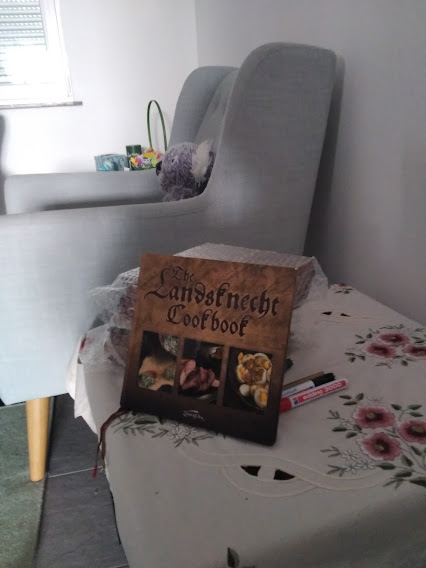My apologies for taking so long – the past two days were rather exhausting. Thanks to a most gracious hostess, I was able to hold a booksigning party to mark the launch of my Landsknecht Cookbook and prepare a Renaissance feast for the occasion.
First off: Yes, the English edition of the Landsknecht Cookbook is now available. You can order it directly from the publisher who will ship worldwide. I am hoping retailers in the US and elsewhere will also pick it up to bring down shipping costs.

To celebrate the occasion, I visited a group of medievalist friends in South Germany and brought some copies along to sign. These are the Kickstarter special edition which is currently shipping to subscribers and of which a few copies are still available.
And more to the point, we enjoyed a spread of Renaissance food that would have graced the tables of senior officers, and even that probably rarely. This is luxury:
Deer Backstrap in Pastry
As the hostess is also an avid and skilled hunter, she was abile to provide fresh backstrap of roe deer for me to use in one of my favourite recipes. This is from the 1460 manuscript ascribed to Meister Hans:

A back roast of roe deer make thus:
Item of the back roast of roe deer: lard it well with small pieces of bacon (speck), strew it well with salt and throw upon it pepper, ginger and caraway.
Wrap around it (bewind es mit) a dough as though for small krapfen (filled pastries) and let it bake in an oven. Await, judging by the lightness (of the dough) whether it is baked entirely. You may also bake hare in one piece this way.
The meat was absolutely wonderful, and I only rubbed it with salt, pepper, ginger, and caraway. That turned out to be a winning combination. Covered with fat bacon (German Rückenspeck) and wrapped in a crust that I then decoratively brushed with egg and sprinkled with whole caraway seeds, it cooked to soft perfection.

The crust is loosely based on historical recipes for unleavened krapfen crusts, with a relatively high proportion of egg to fat which made it easy to roll out and seal, but less pleasing to eat. It was still quite good, but its main purpose was to lock in the moisture and flavour as the meat slowly cooked at a low temperature (140°C). We sliced it just in time to serve. The deer came out fully cooked, soft, but not mushy, juicy and tender. My only regret is that it was gone so quickly.
Renaissance Salads
I had considered a variety of vegetable dishes – mashed peas, leeks in almond milk, spinach in butter sauce, or mashed parsnip – but in the end, I opted for salads. Saturday was the peak of our first summer heat wave with 35°C outside, so this turned out to have been a good choice. The recipes were chosen from among a plethora of options available from Marx Rumpolt, all proven favourites:
Take a red cabbage/ cut it very small/ parboil it a little in warm water/ cool it rapidly/ mix with vinegar and oil/ and when it lays awhile in the vinegar/ then it will be beautiful red.

Green mache/ sprinkled with pomegranate seeds is beautiful and elegant.

Peel the Cucumbers/ and cut them wide and thin/ mix them with oil/ pepper and salt. If they are salted/ then they are also not bad/ they are better than raw/ for one can salt them down with fennel and with caraway/ that one can keep over a year. And on the Rhine river (in the Rhine valley) one calls it Cucummern.

Red Beet salad/ when it is boiled/ then cut them small/ long or cubed/ mixed with oil/ vinegar and salt/ like to make them sweet or sour.

Take lemon/ chop them small/ mix with fair clear sugar/ that was crushed a little/ sprinkle with pomegranate kernels/ that are nicely red/ like this it is also elegant and good.

All of these were popular and complemented the meat well. Tomorrow, we will talk about the game hens and the crawfish pies.
